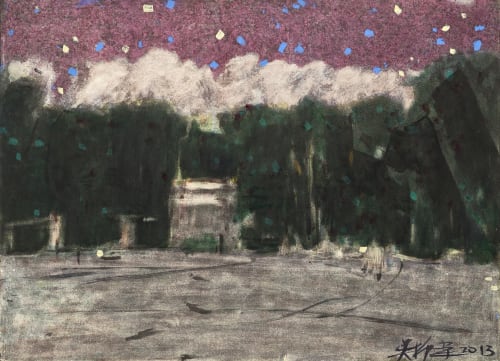Mind Set Art Center is honored to once again collaborate with curator ROAH Ching-Yueh and present “WU Tseng Jung: Mountain Tones”. This is the first time that WU, an architect-turned-painter, showcases his collection of paintings made during the past 30 plus years. The exhibition is scheduled to run from July 27 through September 7, with an opening ceremony set for 4:30 p.m. on July 30. We extend a warm invitation to you to join us for the event.
In his novel “The Sound of the Mountain”, Nobel Prize winner Yasunari Kawabata writes the following passage:
“In these mountain recesses of Kamakura the sea could sometimes be heard at night.
“He wanted to question himself, calmly and deliberately, to ask whether it had been the sound of the wind, the sound of the sea, or a sound in his ears. But he had heard no such sound, he was sure. He had heard the mountain.
“It was as if a demon had passed, making the mountain sound out.”
With the words of Yasunari Kawabata, curator ROAN Ching-Yueh presents to us the 20 plus watercolor paintings of WU Tseng-Jung, which were made during a span of over 20 years (from 1995 to 2019). Much like Kawabata’s novel that comprises many short proses, WU’s paintings are like individual chapters that are connected and come together to form an obscured and abstract view. In his commentary, ROAN said, “WU Tseng Jung’s paintings exhibit a pure and poetic aesthetics that is akin to Kawabata’s writing. He portrays imaginary scenes where he finds himself in distant mountains, gazing into the reflection of the moon on the surface of the lake. In his paintings, one is at once immersed in the beauty of the landscape and facing the harsh reality. With the interplay between romantic imagination and the real world, as well as the overlapping color patches on his canvas, WU manages to create a tone that reverberates between mountains and captures the intricate sentiments of humans. The aesthetics in his paintings reflect that of eastern philosophy, not unlike the ideas discussed in ‘In Praise of Shadows’.“ In “Distant View of Mount Jade”, WU divides his frame into three sections, each of which is dominated by a different patch of color. He effectively combines elements of abstract minimalism with traditional brushstrokes of Chinese ink brushes to create a splendid view of Mount Jade in the distance. The work is both a landscape painting and WU’s projection of his inner essence – an unwavering soul that stands on its own, much like the mountain. In “Three Black Dogs”, a painting that WU started in 1996, two dogs walking in the foreground are dwarfed by the immense view of the sky. WU has somehow managed to infuse a weighty sense of spirituality with diluted paint. The result is a painting that continues his effort to combine abstraction with eastern aesthetics.
WU’s design of the Dongshi District Office brought him recognition early on in his career. He incorporated his childhood experience of herding cattle into the design, and ended up nicknaming the building “The Smiling Cattle”. However, after winning the bid for the coveted project of designing the Taipei City Hall, he disregarded the massive expectation and decided to abruptly end his architecture career and to devote himself instead to painting. He has since lived a reclusive life and made little public appearance at professional events in architecture, adding an aura of mystique. Architecture critic WANG Tseng-Yung commented on WU in his book “Architectural Attitude”, describing him as “an ineloquent loner who seldom communicates with anyone. He simply focuses on his work with a stubborn drive. Like many Japanese architects we know, WU strives to develop his own design style — a challenge that few in Taiwan have the determination to tackle.” The rare talent and drive have made WU an auteur in the field. During his 20-year working as an architect, WU has accumulated much experience in dealing with complex spaces. This helps him perceive spatial relations in a unique manner and allows him to deconstruct concrete objects in his mind and express his own interpretations. WU understands that the idea of flowing spaces in modern architecture is rooted in the perception of blurred boundaries between light and shadows. This visual knowledge has translated into the murky edges between different color patches in his paintings. When looking at his canvases, we can visualize the scenes in which WU walks tirelessly through the streets and mountains while pondering the significance of the interactions between men and the environment, as well as his profound love for the land.

